About Mayne Island
History & Natural Habitat

Mayne Island has many traditional landmarks.
Some forty million years ago the earth´s shifting tectonic plates were thrusting Mayne Island out of the sea. Native people were fishing in Active Pass, around Helen Point, as long ago as 3000 B.C.
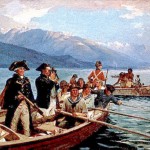
George Vanvouver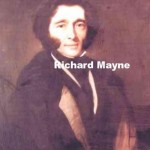 Richard Mayne
Richard Mayne
Spanish explorers visited in the late eighteenth century, giving Spanish names to Galiano, Juan de Fuca Strait and the San Juan Islands. In 1794 Captain George Vancouver camped on Georgina Point, where his crew left a coin and knife found over a century later by early settlers.
In the 1850s Captain George Richards of the Royal Navy began surveying the area aboard H.M.S. Plumper. He named our island after his lieutenant, Richard Charles Mayne, and he named the pass between Mayne and Galiano after his ship, but changed his mind when he learned that the American survey ship U.S.S. Active had been the first steam vessel to navigate the pass.
The earliest homesteaders registered land claims in the Miners Bay area in 1859. Miners Bay owes its name to adventurers bound for the Cariboo Gold Rush of 1858, the halfway stop between Vancouver Island and the mouth of the Fraser River.
Working farms began in the 1890′s, and in 1887, Canon Paddon founded the Church of St. Mary Magdalene. A little earlier, the Springwater Lodge opened, and in 1896 the Plumper Pass Lockup was built to cool off those whose tempers were not soothed by either church or saloon. The gaol is now a small museum.
Apple orchards were flourishing before the turn of the century and the Mayne Island King Apple was among the first planted in B.C. Richard Hall, the Tomato King, on his return from World War I, built a greenhouse so large the horse-drawn cultivators could be driven through it and the loading of his produce disrupted the schedules of the island steamers leaving Mayne. Japanese settlers followed his example and the greenhouse tomato business flourished until the start of World War II when the Japanese were forced to move away from the coast to other parts of Canada. Dinner Bay Park with its recreational facilities and a new Japanese Garden, is located on an old Japanese farm. This garden is dedicated to our early Japanese settlers.
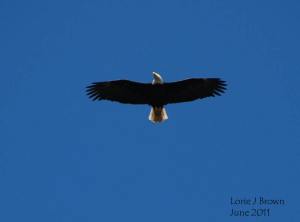
Photo by Lorie Brown
Over 250 different wild flowers grow and flourish on Mayne Island, from Blue-eyed Marys to rare orchids, common daisies, wild native roses and bluebells, brought to the island by early settlers. Browsing on many of the wild flowers and plants, causing aggravation to many a gardener, are the Banana Slug and Black-tailed Deer. There are no bears, cougars or coyotes on Mayne.
Much of the island is covered by trees – Douglas and Grand Fir, Western Red Cedar, Alder, Maple and Arbutus, and in the shade of the trees grow Honeysuckle, Huckleberry, Salal and Oregon Grape.
In our waters, seals, sea-lions, salmon, sole and killer whales splash and swim. In the intertidal zone, pools formed by depressions in the sandstone are home to many small creatures.
One of our greatest natural assets is the number and variety of birds which live here or visit us. The tiny Winter Wren, stately Bald Eagle, Robins, Finches, Towhees, and in Spring the Hummingbirds and Swallows. Summer brings the Goldfinches, Cedar Waxwings, and in Autumn flocks of shorebirds migrating south stop to rest and feed on the mudflats at Horton Bay and Village Bay. Those are only a small sample of the dozens of different species which make Mayne Island a birdwatchers’ dream.
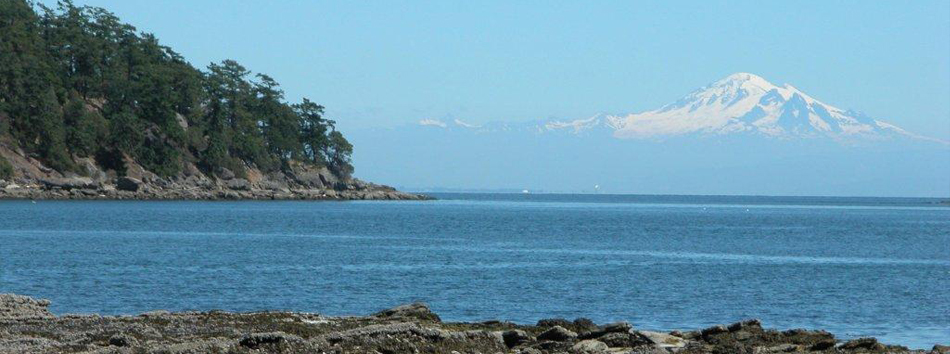
Getting to Mayne Island
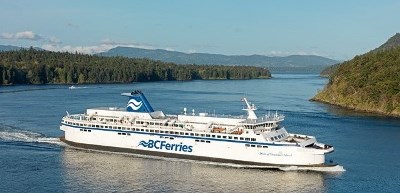 Vehicle reservations are recommended between the mainland and Mayne Island, but are not available between Swartz Bay and Mayne, nor for inter-island travel.
Vehicle reservations are recommended between the mainland and Mayne Island, but are not available between Swartz Bay and Mayne, nor for inter-island travel.
For recorded schedule and fare information 24 hours a day on most routes, or for reservations and further information 7 am to 10 pm daily: Victoria Area & Outside of B.C. (250) 386-3431; Elsewhere in B.C. 1-888-BCFERRY (223-3779).
WASHROOMS in the country are as hard to find as they are in the city. The public facilities are located at the Ferry Terminal, Dinner Bay Park, and Georgina Point Heritage Park. Public washrooms are available in Miners bay at the new Park & Library complex.
TELEPHONES for the public are located at the Ferry Terminal, the Blue Vista Resort, the Trading Post, Mayne Street Mall, and RE/MAX Mayne-Pender.
CYCLING on Mayne Island is a real up and down affair. Our narrow hilly roads can lead to dangerous situations when cycling groups, overtaking and on-coming traffic all occur at once on a blind curve. Heads up and single file only!
HUNTING is not permitted on the island nor is the discharge of firearms. So the garden-fed deer are almost tame and sheep may safely graze.
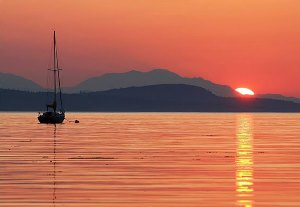
FISHING has been a popular local pastime for about 5000 years, but in the present age licenses are required, and available at the Gas Station. Don’t hesitate to enlist the aid of a cheerful local, or two, to aid you up the dock with your monster catch.
FIRES pose a severe hazard on our heavily forested island. Outside fires are strictly forbidden during the hot, dry summer months. Please carefully extinguish cigarettes.
WATER needs to be conserved, especially in the dry summer.
WEATHER Annual rainfall averages about thirty inches (750 mm), less than half of Vancouver’s. Average summer temperatures are usually in the low 20’s Celsius (about 75º F). Winter averages rarely go below freezing and it seldom snows though once in 1989 we had a temperature of -12º Celsius (10º F).




